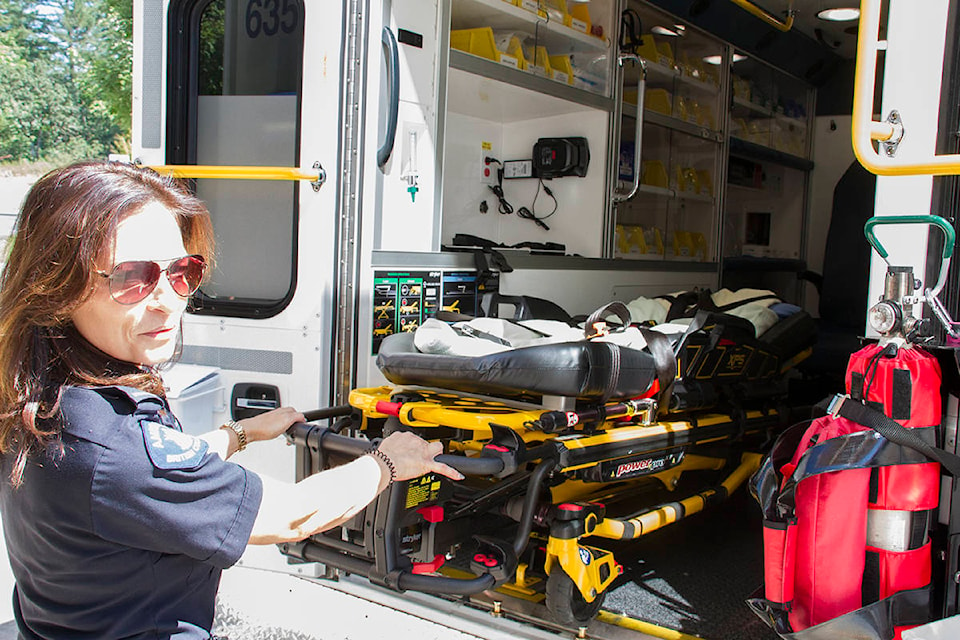The province is promising better health care for residents in Kamloops, Chase and nearby regions with the announcement of new paramedics and ambulances.
Health Minister Adrian Dix made the announcement Tuesday morning that the region will receive 21 new paramedic positions and two ambulances.
“This is meant to support the health of people living in Kamloops, Chase and the region,” said Dix.
He said 18 new full-time paramedics will be hired for Kamloops, adding to the 24 full-time paramedics already on staff. Two new ambulances will also be brought in, adding to the five already in service in the area.
In Chase, the government is adding three full-time paramedic positions.
“This will provide regular staffing seven days a week in Chase,” said Dix. “This is part of a provincial plan, particularly in the Interior, to improve ambulance service everywhere.
“These are significant increases in response to the growing number of calls in the region. These are growing regions of B.C., so this allows for better staffing and better response times.”
New paramedics are expected to be on the ground in the new ambulances by the end of 2018, early 2019. @adriandix #Kamloops #ChaseBC @BlackPressMedia
— Carmen Weld (@carmenweld) September 18, 2018
The minister says they hope to have the new paramedics on the ground by the end of 2018 into early 2019.
“We expect most hirings to be internal, people that are not yet in full-time positions now but in the system,” explained Dix.
“This is a necessary step that reflects changes in the ambulance service over the last couple of decades. What the ambulance service was and needs to be required a transformation. Since I’ve become minister there has been 69 new paramedic positions, largely across the Interior and Vancouver Island.”
Dix said these additions will do a lot in this region to improve both wait times and response times.
“If you need an ambulance that is the most important thing, the most important government service at that moment, the wait can be intolerable,” said Dix.
“We’ve seen a significant increase in call volumes which lead to an increase in response times. We thought this was an appropriate response today.”
“We are very proud of this, proud of @BC_EHS everyday, the work they do is remarkable. Not just in difficult times, but everyday," said @adriandix
— Carmen Weld (@carmenweld) September 18, 2018
"This is good news for #Kamloops , good news for #ChaseBC and good news for the Interior of BC." @BlackPressMedia
According to the ministry, the increase in overall calls, response times and wait times has become an increasing concern across the board.
The ministry provided the following numbers to showcase the increase in calls per region.
Chase
- 2016: 546 calls made to 911 for medical emergencies
- 2017: 699 calls made to 911 for medical emergencies
- Wait times increased in that year from 8 minutes 53 seconds to 10 minutes nine seconds.
Kamloops
- 2015: 12,243 calls made to 911 for medical emergencies
- 2017: 13,351 calls made to 911 for medical emergencies
- Wait times increased in those two years from 8 minutes 27 seconds to 8 minutes 51 seconds.
Additionally;
Kelowna
- 2015: 16,950 calls made to 911 for medical emergencies
- 2017: 19,847 calls made to 911 for medical emergencies
West Kelowna
- 2015: 3,944 calls made to 911 for medical emergencies
- 2017: 4,550 calls made to 911 for medical emergencies
“All of those increases, given a relatively stable number of resources, meant a slight but important increases in response times,” said Dix.
For example he said light and sirens response times increased 45 seconds in Lake Country, 46 seconds in West Kelowna and 21 seconds in Kelowna.
“In short, in the last year we’ve made some real progress for the real health issues for the people of Kamloops and the region,” added Dix. “We’re very proud of this, we’re very proud of the British Columbia Ambulance Service everyday, what it means for people in the community is remarkable. Not just in difficult times, such as last summer’s wildfires, but everyday.”
Black Press Media did an in-depth series earlier this year addressing the serious issues with emergency health services in British Columbia and our access to it.
Part 1: ‘People are dying from treatable medical conditions’
Part 2: Reports support claims of subpar care
Part 3: Is there hope beyond Hope?
Part 4: Policy prevents advanced paramedic care in rural areas
To report a typo, email:
newstips@saobserver.net.
@carmenweld
carmen.weld@bpdigital.ca
Like us on Facebook and follow us on Twitter.
